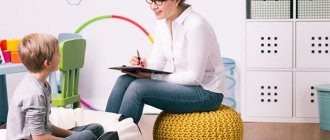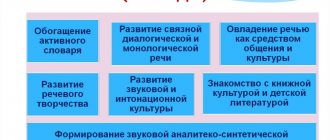Summary of educational activities for the development of self-service skills
Summary of educational activities for the development of self-service skills
Target:
Continue to teach children to independently care for their appearance and the condition of their clothing.
Tasks:
1. Strengthening children’s ability to put things back in their place
2. Formation of clothing care skills;
3. Formation of a desire for neatness; to the ability to notice and correct imperfections in appearance in oneself and other children;
4. Improving the ability to dress independently in the correct sequence;
5. Enrichment of vocabulary with the help of proverbs and sayings on the topic
Progress of the lesson
There's a knock on the door.
Educator:
Children, do you hear, someone came to visit us. Vika, let's go, open the door and meet the guest.
(An upset Luntik enters the group, introduces himself, begins to take off his outerwear and throws things around as he goes.)
Educator:
Hello! What happened, why are you so upset?
Luntik:
"Hello! My name is Luntik. My friends don't invite me to go out with them! So I'm upset. They say I'm sloppy, sloppy! Guys, tell me what these words are, what do they mean? I came to you for help, you know everything in kindergarten and can do everything!
Educator:
Luntik, we will help you! First, children, let's remember what these words mean - sloppy, sloppy?
(This is a person who does not keep his things orderly and clean and does not take care of his appearance.)
What did Luntik do wrong when he joined our group? (Scattered his things.) Let's tell you what you really need to do with them.
Children's individual answers:
- put the boots on the shoe rack,
- hang the jacket on a hook in the locker,
- Put the hat on the top shelf in the locker.
Educator:
And now Vanya and Polina will help me put Luntik’s things back in their places.
So that our advice is not forgotten, remember the proverbs and sayings about neatness that our children know.
Timur:
“The whole world is kept up by neatness”
Masha:
“Where there is neatness, there is neatness”
Seva:
“Whoever is neat is pleasant to people.”
Educator:
All things need to be looked after not only when they are old, but also when they are still new.
Luntik:
Oh, I still have a lot of things here! They're all mixed up and I don't know what to do with them! Teach me how to lay things out! (Pours things out of the bag.)
Several children help Luntik sort things into pairs, and neatly fold unpaired things or hang them on a chair.
Educator:
And our children also know that they need to not only carefully put things in their places, but also wear them carefully and take care of their appearance. Guys, let's look at our guest - what's wrong with his clothes?
(Children notice flaws in the doll’s clothes, and take turns going out to correct them)
- different socks,
- shoes on the wrong foot,
- shirt inside out.
Educator:
Remember one more lesson - “They are greeted by their clothes, but they are seen off by their minds” - this means that first of all people pay attention to the appearance of other people, their clothes, and only then to everything else.
Luntik:
Well done! Guys, you really know everything! You helped me a lot. But I want to see - do you know how to do all this yourself? I'll give you a test - who will dress correctly for a walk?
(The teacher selects 2 children who will show how they know how to dress. The test is carried out several times.)
Luntik:
Well done boys! Now I also know how to dress properly!
Educator
: So we helped Luntik! I hope now he won’t have any problems, and his friends will always invite him for a walk! Guys, let's remember what we taught our guest today? What proverbs and sayings does Luntik need to remember?
Luntik:
Thanks guys, you helped me a lot! I will remember your advice!
Household work in the senior group
The teacher invites the children to sit on chairs placed in a semicircle on the carpet. Suggests considering the following constructors:-Guys, what kind of constructor do we have in our group? (large, medium, small). How are they different from each other? (varies in size).
-Guys, how are we going to wash the construction set? What will we do first? What will we do next?
The teacher listens to the children's answers and offers to tell the sequence of actions.
-Guys. Let's show and tell you how we will wash our constructor.
The teacher offers to talk and show one child a sample action for washing toys (1 child - 1 piece of construction set).
—
Guys, what tools will we use?
The teacher draws the children's attention to the table.
—
What tools do you see? (rag, container with water - basin, detergent - soap, watering can). What are they for?
- Guys, do we need all the tools to wash the toys?
-What's extra? Why?
-Where can we use the watering can?
-That's right, we can use the watering can in caring for plants, but we won't need it for washing toys, let's put it away.
-Do we need all the other tools? Do we leave them?
- Guys, but in order to operate with tools, we must remember the safety rules.
A bowl of water - you can spill water, but what happens if we spill water?
The teacher listens to the children's answers.
Soap, soapy rag - what will happen if we throw them?
The teacher listens to the children's answers.
-Guys, everything will be fine if we follow the rules of behavior and help each other.
-Guys, we need to wash several types of construction sets, and to do this faster, I suggest you unite in teams. Look, multi-colored cards are attached to our construction sets, and on my table there are multi-colored cards, but turned over with the colored side down. I suggest you take turns choosing a card and going to the constructor on which the designation is the same color as yours. The teacher observes the unification of children using lots.
Guys, look carefully, your cards indicate not only the construction set, but also the tool with which you will work, find and put it next to your workplace.
- Guys, we looked at what construction sets we have in our group, remembered how to wash them, chose tools, remembered safety precautions, united into teams and distributed responsibilities among ourselves, we are ready to work, all we have to do is put on our aprons.
The Unobvious Benefits of Self-Care Skills
The obvious bonuses of mastering self-care skills are clear: the baby becomes more independent, and you no longer need to monitor his every step. However, many parents neglect self-care skills, focusing more on developing the child's thinking and creativity. However, teachers and psychologists unanimously argue that self-care makes an unobvious but tangible contribution to literally all areas of a child’s life.
Child cognitive development
Learning a sequence of actions has a beneficial effect on the development of memory and thinking, and is involved in improving the child’s attention. It should also be remembered that the more skills a child has already mastered, the better he will be able to navigate a new situation for him, so self-service skills also contribute to the child’s overall intelligence.
Development of coordination and fine motor skills
Have you ever wondered how well you need to control your body in order to put on a T-shirt, handle a button, or tie your shoelaces? Numerous small actions that the baby has to perform when dressing and other procedures become real exercises for the development of fine and gross motor skills.
Impact on communication with other people
In our society, self-care skills are understood as an indicator of a person’s adequacy; we even unconsciously evaluate people by their appearance and neatness. A child who, by the age of 6-7 years, has problems getting dressed or, even more so, needs help while going to the restroom, will likely become an object of ridicule from peers, and sometimes even from adults. The opposite is also true: a child who does not have difficulties with self-care feels more confident and adapts more easily to kindergarten and school.
Self-care skills are not just about keeping a child tidy; they are skills that affect almost all areas of a child’s development. In addition, visiting kindergarten and communicating with other people causes much less stress for a child if he is able to take care of himself.
What are self-care skills?
First, let's understand what is included in the concept of self-care skills. In general, this is the child’s ability to independently maintain hygiene and perform necessary self-care procedures. Self-care skills include the habit of regularly brushing your teeth and combing your hair, going to the toilet on your own, dressing and undressing, using cutlery accepted in society, and so on. Sometimes self-care skills also include basic communication skills with others.
conclusions
Despite the fact that self-service skills include a fairly significant number of mastered operations, in general, children who do not experience developmental delays cope with these tasks without difficulty. However, parents should remember to set aside time to master these skills through games and lots of repetition.
If a child systematically fails to cope with one or more self-care skills, parents should be wary and, if possible, seek advice from a child psychologist, because such a picture can be associated both with harmless individual characteristics of the child’s upbringing and development, and with more serious problems, for example, attention deficit hyperactivity disorder, and can also be an indicator of the child’s emotional distress.
How to help your child develop his skills?
Of course, the question arises, how to help a child master all these numerous and sometimes complex skills? Having collected the experience of other parents and recommendations from teachers, we have identified five tips for instilling independence in children in everyday matters:
- Create colorful step-by-step instructions or checklists and hang them on the wall. Such cards will help kids remember the order of actions, which is especially important when getting dressed, when the child has to keep a long chain of operations in his head.
- Divide complex actions into small steps. Don’t try to teach your child everything at once; break down entire tasks into a sequence of individual operations. Today we learn to pull on socks, tomorrow we learn to put our foot into a shoe, and the day after tomorrow we focus on Velcro.
- Be consistent. Make it a rule that while the child is small, he solves one everyday problem in one way, this will allow him to quickly learn the necessary actions. You will expand your repertoire and work on creativity after mastering the basic skill, but for now try to keep things in their place, personal care procedures have their own routine, and a new hygiene item or item of clothing is not too different from its predecessor.
- Use short and clear instructions. What to take, what actions to take. Repeat instructions without changing the sequence of actions and use the same words and wording, this promotes memorization.
- Allow enough time. “We don’t have time to wait while he digs around!” — parents are indignant when we begin to understand the reasons for the child’s lack of independence. This approach not only does not allow the child to develop, but also exposes him to constant stress. Imagine if, after a couple of demonstrations, you were forced to quickly tie special sea knots or play some melody without mistakes. This is exactly how the child sees the situation. There are two options: initially allocate twice as much time for the necessary procedures or, as a last resort, help him complete the task.
Summary of work activities in the senior group
Summary of the event
labor activity
in the senior group
topic: “Cleanliness is the key to health”
Software tasks:
Improve children's ability to wash toys and dry them. To consolidate and expand ideas about how to care for indoor plants. Form the habit of a healthy lifestyle; the ability to interact in a team, agree on the scope of everyone’s work, and bring the job started to completion. Foster a caring attitude towards plants and a desire to care for them; cultivate hard work, responsibility for the assigned work, accuracy, and collectivism.
Methods and techniques:
explanations, reminders, conversation, play time, advice, demonstration, positive example, practical cleaning actions; encouragement, artistic expression, musical accompaniment, experimentation
Previous work:
Familiarization with the rules of collaboration; with proverbs and sayings; conversations: “Our house - let’s put it in order”, “A small task is better than a lot of idleness”; figurative-plastic sketch “Guests have come to us”; listening to music: Polish song “Boots”, music. R. Boyko “It Was in Carolina”; reading V. Dragunsky “Top to bottom, diagonally”, Y. Akim “The Incompetent”, S. Mikhalkov “All by myself”, A. Barto “The Dirty Girl”
Equipment:
watering cans, napkins, sponges, basins, aprons, sticks for loosening the soil, spray bottle, toys, indoor plants.
Progress:
Buratino (toy) sits in the group and sneezes.
Educator:
Guys, look, Pinocchio came to visit us, but he doesn’t look very healthy! Pinocchio, are you sick? Why are you sneezing all the time?
Pinocchio:
Yes, I have a cold!
Educator:
Haven’t you been taught that patients should be treated at home and not spread infections or germs?
Pinocchio:
Who are these microbes?
Educator:
These are the ones who spread various diseases.
Pinocchio:
I didn't bring anyone.
Educator:
You didn’t bring it, but you sneezed without covering yourself with a handkerchief. The microbes scattered throughout the group, we will now show you how this happens.
Demonstration of experience with a spray bottle.
Pinocchio:
Oh. How many microbes I brought to you, what should I do now?
Educator:
You, Pinocchio, should go home and get treatment, and let’s
think
about what we can do?
Pinocchio leaves.
Children
: You can wipe the dust on the shelves in the closet, wipe off the toys, and arrange them beautifully. We also know how to wash building materials...
We can wash the flowers and water them so that they enrich the air more with oxygen.
Educator:
These are the things we will do.
I suggest you think about what equipment you will need to wash building materials. What is more convenient for wiping toys?
Before starting work, I suggest you remember the basic labor rules:
- You can't be distracted.
- Carry out any task carefully, bring the work started to the end.
-Help your comrades, if they refuse help, do not interfere.
I distribute the guys into groups and give each group a task.
I suggest distributing the work yourself. (Turn on music)
The children get to work. The teacher and the Storyteller help with advice and sometimes show the method of action.
If necessary, the teacher redistributes work responsibilities.
After work, children clean up after themselves with napkins, sponges, and aprons.
When assessing the children’s work, the teacher summarizes:
Educator:
You guys did a great job. They did a lot of useful things, worked together, helped each other. It’s not for nothing that people say: “Friendly - not burdensome!” And they also say “Patience and work will grind everything down!” The group became clean, beautiful, and flowers from proper care will delight everyone with beautiful greenery and flowers. And most importantly, we got rid of germs!




